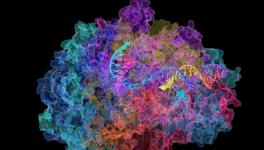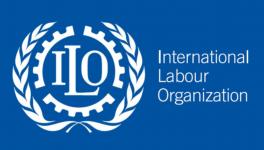Technological Advancements and a Belief in Basic Science: The Story of the Nobel Chemistry Prize 2017
The Nobel Prize for Chemistry this year has been awarded to scientists who developed, for the first time, a technique to visualise biomolecules in their natural configuration. Jacques Dubochet, Joachim Frank, and Richard Henderson, who developed this technique – called cryo-electron microscopy – will receive equal shares of the prize money of 9 million Swedish kroner.
All three scientists made different contributions for the successful development of this technique, which is now being used to study molecules such as those in the Zika virus, and proteins involved in Alzheimer’s disease. It can lead to some unprecedented developments in the field of pharmaceutical developments as well. Joachim Frank said in a statement that the technique has “immense” potential, and means that medicine no longer has to focus on organs, but can look “at the processes in the cell”.
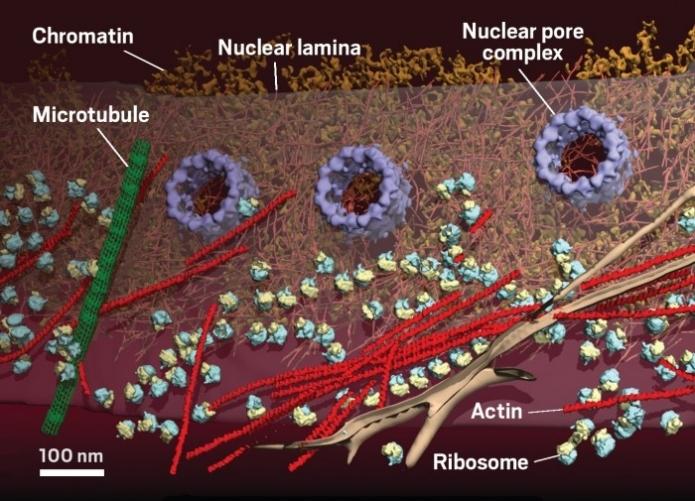
Nucleus of a Cell, Credits: Chemical and Engineering News
It allows for the exploration of biological processes in film-like sequences by stitching together images of molecules taken at different points in time, as they experience changes in their environment. Thus, it will let us see in real time, how a change in external conditions affects biological molecules.
Before cryo-electron microscopy (cryo-EM), other imaging techniques were being used. However, they had certain limitations. X-ray crystallography, for instance, was widely used, but require molecules to be in a crystal form. Many proteins and enzymes do not crystallise at all. Electron microscopes are also popular, but can only image dead matter as the electron beam emitted to inspect the molecular structure often destroys the very structure it images. Cryo-EM tackles these problems by performing three steps:
1. It uses weaker electron beams so as to prevent the protein or enzyme from being destroyed.
2. Instead of freezing a molecule into ice crystals which would hinder the imaging process, it turns the water inside the cells into a glassy state. This allows biological molecules to be frozen in time while retaining their natural form.
3. It uses an algorithm which can take multiple two-dimensional pictures of the molecule from different angles, and convert them into a three-dimensional structure.
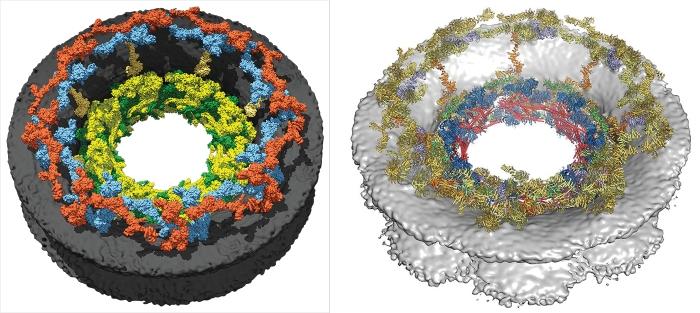
Structure of Nuclear Pore Complex, Credits: Chemical and Engineering News
An interesting point to note in the development of this technique is the crucial role played by software, algorithms, and the advances in computational power. Joachim Frank created the image processing algorithm that can analyse and merge different two-dimensional images of a molecule into a three-dimensional structure. This required the use of computational geometry. The algorithm identifies similarities in thousands of different images generated by the electron microscope. It then merges them together by finding out the highest clarity available for each section of the structure from the different images. The resolution thus achieved is at an atomic level. Cryo-EM can determine the position of every atom forming a molecule, a clarity never before seen in the images of biomolecules.
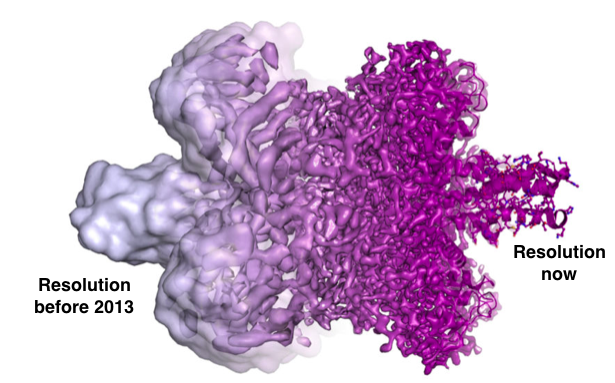
Credits: The Royal Swedish Academy of Sciences
It can be concluded that the development of algorithms and increase in processing power of computers plays an essential role in scientific research nowadays. It allows for the analysis of huge datasets which was previously difficult and slow.
The credit for this research should also go to institutions that allow scientific research to be carried out without the pressure of making economic gains.
Venkatraman Ramakrishnan, the President of the Royal Society, has said that this year’s Nobel Chemistry Prize underscores the importance of patiently supporting basic science for decades. “It has already been used by drug companies to do structures of important drug targets, and it is used to understand fundamental biology that can change medicine in the future – so it just goes to show you how all these things are linked,” he said.
This serves as an important lesson for scientific research in India which is currently facing a funding crunch, and is being badgered to create more profits instead of being focussed on advancing the frontiers of scientific knowledge, both for the sake of knowing, and for the larger benefit of society.
Disclaimer: The views expressed here are the author's personal views, and do not necessarily represent the views of Newsclick.
Get the latest reports & analysis with people's perspective on Protests, movements & deep analytical videos, discussions of the current affairs in your Telegram app. Subscribe to NewsClick's Telegram channel & get Real-Time updates on stories, as they get published on our website.









